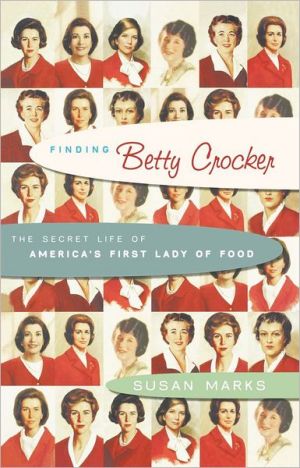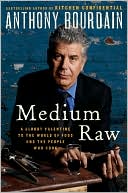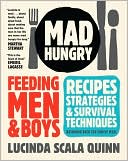Finding Betty Crocker: The Secret Life of America's First Lady of Food
IN 1945, FORTUNE MAGAZINE named Betty Crocker the second most popular American woman, right behind Eleanor Roosevelt, and dubbed Betty America's First Lady of Food. Not bad for a gal who never actually existed.\ "Born" in 1921 in Minneapolis, Minnesota, to proud corporate parents, Betty Crocker has grown, over eight decades, into one of the most successful branding campaigns the world has ever known. Now, at long last, she has her own biography. Finding Betty Crocker draws on six years of...
Search in google:
IN 1945, FORTUNE MAGAZINE named Betty Crocker the second most popular American woman, right behind Eleanor Roosevelt, and dubbed Betty America's First Lady of Food. Not bad for a gal who never actually existed."Born" in 1921 in Minneapolis, Minnesota, to proud corporate parents, Betty Crocker has grown, over eight decades, into one of the most successful branding campaigns the world has ever known. Now, at long last, she has her own biography. Finding Betty Crocker draws on six years of research plus an unprecedented look into the General Mills archives to reveal how a fictitious spokesperson was enthusiastically welcomed into kitchens and shopping carts across the nation.The Washburn Crosby Company (one of the forerunners to General Mills) chose the cheery all-American "Betty" as a first name and paired it with Crocker, after William Crocker, a well-loved company director. Betty was to be the newest member of the Home Service Department, where she would be a "friend" to consumers in search of advice on baking -- and, in an unexpected twist, their personal lives.Soon Betty Crocker had her own national radio show, which, during the Great Depression and World War II, broadcast money-saving recipes, rationing tips, and messages of hope. Over 700,000 women joined Betty's wartime Home Legion program, while more than one million women -- and men -- registered for the Betty Crocker Cooking School of the Air during its twenty-seven-year run.At the height of Betty Crocker's popularity in the 1940s, she received as many as four to five thousand letters daily, care of General Mills. When her first full-scale cookbook, Betty Crocker's Picture Cook Book, or "Big Red," as it is affectionately known, was released in 1950, first-year sales rivaled those of the Bible. Today, over two hundred products bear her name, along with thousands of recipe booklets and cookbooks, an interactive website, and a newspaper column.What is it about Betty? In answering the question of why everyone was buying what she was selling, author Susan Marks offers an entertaining, charming, and utterly unique look -- through words and images -- at an American icon situated between profound symbolism and classic kitchen kitsch. Publishers Weekly "Your talks... have given me hope," wrote one listener to the Betty Crocker radio program during the Depression, and according to Marks's largely chronological "biography" (there was no real Betty Crocker), it was human connections like this one that made Crocker one of the most successful marketing tools ever. Filled with treasures from the General Mills archive-including letters sent to Crocker during WWII, reprints of famous recipes and advertisements, and portraits updated through the years-Marks's book introduces readers to the people who breathed life into Crocker's image as the happiest of homemakers. There's Samuel Gale, her inventor, and Florence Lindeberg, who provided her trademark signature in 1921. Other important figures include Neysa McMein, who painted the first Crocker portrait in 1936, and Adelaide Hawley, who played Crocker on television in the 1950s. Marks, who created a documentary film on Crocker, devotes a chapter to the Betty Crocker Kitchens and chronicles the products that Crocker's folksy persona sold to the world, like Bisquick and various cake mixes. In another section, she touches upon-albeit too briefly-Crocker's role in "the fundamental shift in American diets toward... factory-processed convenience foods." Light on analysis but abundant with anecdotes, this is a solid basic history for casual culinary, marketing and American historians. Photos, illus. Agent, Dawn Frederick. (Apr.) Copyright 2005 Reed Business Information.
Introduction\ The day before the Fourth of July, I stopped by my parents' house and was not surprised to find my mother busy in the kitchen, baking a red-, white-, and blue-layered cake from Betty Crocker mixes.\ "Do you remember when I thought you were Betty Crocker?" I asked.\ My mother smiled. "I sure do."\ "You were about seven," she recalled, "and it was your turn to bring the treat bucket to your Brownie troop meeting. Instead of buying something, I thought it would be fun to bake cookies together. So I found a chocolate chip cookie recipe from my files called 'Betty Crocker's Bisquickies.'"\ "You seemed delighted, so I suggested we bake another batch sometime," my mother explained. "Then you stood right here at the kitchen counter and started flipping through my Betty Crocker cookbook and became convinced that Betty's picture was actually me."\ While my mother and I baked the Bisquickies, she shared her childhood memories of an ongoing debate about Betty Crocker. Was she a real person? Household opinion was deeply divided. In the spring of 1950, my grandma wrote to Betty Crocker for some advice on meal planning and received a reply in return. But, she wondered, was the letter signed "Cordially yours" truly from "Betty" herself?\ Absolutely, thought my mother, because Betty had her own radio show and cake mixes. Years later, a women's magazine called Betty "an ageless thirty-two." As a kid, my mother's powers of reason were wholeheartedly straightforward. In her mind, "ageless" was proof that Betty Crocker had an age, just as any real woman did. But my grandmother still wasn't so sure.\ Fast-forward to 1998: my grandmother was visiting from out of town. She was thrilled to hear that I was writing a book on Betty Crocker and promised to bring Betty Crocker recipe booklets on her next visit. As we sat and talked, memories came flooding back. For years, she saved Betty Crocker coupon "points" to help my mom fill her hope chest with Betty's Oneida "My Rose" silver pattern. I was surprised to hear my grandmother speak of how controversial cake mixes such as Betty's were when they first came on the market.\ With her next visit came an unexpected surprise. Standing in my parents' kitchen, my grandmother handed me something she had cherished since 1950. It was that letter from Betty Crocker. For the first time in my life, I was speechless.\ I never imagined that this little piece of history would survive all these years. So much of culinary history is steeped in an oral tradition — mothers teaching daughters, who in turn share their stories of kitchen wisdom with daughters of their own. But Betty Crocker had a hand in changing all that. Before cookbooks and recipe files were commonplace, Betty encouraged my grandma, and millions of Americans like her, to write in search of answers, guidance, or friendly advice.\ Into this great divide stepped Betty Crocker with her kitchen inspirational, "You can do it, and I can help you." Empowered by her words, countless women — and men — made a collective connection, not to Betty Crocker the corporate symbol, but to Betty Crocker the person. But who was she, really? Finding Betty Crocker chronicles an American search for her identity that stretches over fifty states and across the turn of a century.\ "Born" in 1921 in Minneapolis, Minnesota, to proud corporate parents, Betty Crocker has grown, over eight decades, into one of the most successful branding campaigns the world has ever known. In 1945, Fortune magazine named her the second most popular American woman, right behind Eleanor Roosevelt, and dubbed Betty America's First Lady of Food. And in 2000, an Adweek poll revealed that a majority "voted" for Betty Crocker in a mock presidential contest, beating out a ballot of five other (Mr. Clean, Mr. Goodwrench, Aunt Jemima, Ronald McDonald, and Cap'n Crunch) brand icons.\ What is it about Betty that has motivated so many Americans to award her a place in their hearts and minds? The sheer magnitude — and longevity — of her popularity speaks volumes of the need she has fulfilled in countless lives. Millions have traveled to Minneapolis to tour the Betty Crocker Kitchens, hoping to catch a glimpse of this beloved national icon. And more than a few devoted fans left in tears when they discovered it was impossible to meet her.\ But to all the people she's helped, instructed, and even inspired, Betty Crocker has heart. And so she lives on. As for her enduring appeal, perhaps this Depression-era radio listener expressed it best, "Your talks, Betty Crocker, have given me hope."\ Copyright © 2005 by Susan Marks
Introduction11The Making of an American Myth52Betty Goes Hollywood453On Betty's Watch834Bake Someone Happy1275Just Add Water!1496Kitchens of the World1777Strangely Familiar207Notes247Acknowledgments273
\ Publishers Weekly"Your talks... have given me hope," wrote one listener to the Betty Crocker radio program during the Depression, and according to Marks's largely chronological "biography" (there was no real Betty Crocker), it was human connections like this one that made Crocker one of the most successful marketing tools ever. Filled with treasures from the General Mills archive-including letters sent to Crocker during WWII, reprints of famous recipes and advertisements, and portraits updated through the years-Marks's book introduces readers to the people who breathed life into Crocker's image as the happiest of homemakers. There's Samuel Gale, her inventor, and Florence Lindeberg, who provided her trademark signature in 1921. Other important figures include Neysa McMein, who painted the first Crocker portrait in 1936, and Adelaide Hawley, who played Crocker on television in the 1950s. Marks, who created a documentary film on Crocker, devotes a chapter to the Betty Crocker Kitchens and chronicles the products that Crocker's folksy persona sold to the world, like Bisquick and various cake mixes. In another section, she touches upon-albeit too briefly-Crocker's role in "the fundamental shift in American diets toward... factory-processed convenience foods." Light on analysis but abundant with anecdotes, this is a solid basic history for casual culinary, marketing and American historians. Photos, illus. Agent, Dawn Frederick. (Apr.) Copyright 2005 Reed Business Information.\ \ \ \ \ Library JournalShe hosted a radio show that reached millions and at the height of her popularity received more than 4000 letters a day. Her "Big Red" cookbook sold more than 30 million copies. She not only helped get America through a depression but boosted morale on the home front during World War II. And she became America's foremost cooking authority. Yet Betty Crocker was never a real person but instead one of the most successful brands in history. This deliciously fun "biography" begins with Betty's "birth" in 1921 in Minneapolis-the result of a wildly successful promotional effort by Gold Medal Flour executives, who needed a woman to respond to letters from customers. Marks, whose interest was stimulated by a Betty Crocker letter her grandmother received and who spent six years researching the General Mills archives, traces Betty's evolution as a corporate spokesperson and brand, offering a fascinating look at American culinary history. Spiced with a small selection of recipes from Betty's files and graced with some wonderful illustrations, this is popular history at its best: both informative and entertaining. A natural complement to Anne Mendelson's Stand Facing the Stove: The Story of the Woman Who Gave America The Joy of Cooking; highly recommended.-John Charles, Scottsdale P.L., AZ Copyright 2005 Reed Business Information.\ \ \ Kirkus ReviewsCheerful social history follows the career of General Mills's long-lived celebrity spokeswoman. First things first: Betty Crocker isn't a real person. She was created, in an unwittingly brilliant move, by the publicity department of Washburn Crosby, makers of Gold Medal Flour, after a magazine contest brought in a flood of cooking questions to the company. The letters were answered, but the male publicity director certainly couldn't sign his own name to the responses; thus was Betty created. Her last name was given in honor of then-recently retired company director William G. Crocker, but her first name was chosen simply for its "wholesome" sound. From these simple origins, an empire grew-one supported by a large staff of cooks and home economists who were constantly testing recipes and looking for kitchen innovations. Betty was a radio pioneer, with a first show debuting in 1924 and, later, with her Betty Crocker Cooking School of the Air. She went to Hollywood in the '30s to interview the stars, Marjorie Child Husted being the public face of Betty Crocker on these occasions. Betty assisted homemakers in stretching their budgets during the Great Depression and offered innovative ways to cook with rations during WWII. And while Betty Crocker was always firmly in the woman-as-homemaker camp, she advocated greater recognition for what was often thankless work, creating the Betty Crocker Home Legion. In the 1950s, Betty Crocker offered convenience foods-Bisquick, cake mixes-that matched the shiny new postwar prosperity. Though her popularity hit its high-water mark in the middle of the 20th century, she remains a force even in the General Mills of today. Marks excels in putting her subjectin context, and alongside her historical account, she places numerous letters from women who wrote to Betty to ask questions or inform her about their lives. Like a Betty Crocker recipe: goes down easy.\ \








